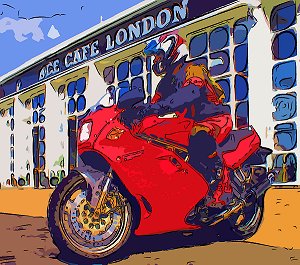|
|
 |
|
Brent
|
 |
|
Regarded as the southernmost part of Wembley, Alperton was once the smelliest place in Middlesex. First recorded in 1199,
the name may have meant ‘apple farm’. By 1433 the village had a wooden bridge across the River Brent. Stag hunting
was a popular pursuit hereabouts in Tudor and Stuart times. Alperton’s transformation began with the arrival of the
Grand Junction (now Grand Union) Canal in 1801. Pleasure boats brought day-trippers and anglers. Brickworks were established,
shipping their products by barge, as did farmers with hay for London’s horses. By the mid-nineteenth century Alperton
had become the most industrialised village in the Wembley area, reeking of horse manure, sewage and pig dung and polluted
by dusty brickfields. Tile and brick making ceased around 1890 and the newly created Wembley urban district council helped
to clean up the noxious industries from 1894. Alperton’s station opened in 1903, originally as Perivale-Alperton. Early twentieth century businesses included mushroom cultivation and the manufacture of rubber products, fireproofing
and Wooler’s ‘Flying Banana’ motorcycles. The construction of the North Circular Road brought more industry
in the 1920s and 30s. The district was almost fully built up by 1933 but underwent a decline after the Second World War, with
a fall in population. From the 1970s East African Asians, many of Gujarati origin, began to move to Alperton. The new community
brought a revival to the shopping parade on Ealing Road, selling a variety of specialist products – especially jewellery,
sometimes crafted at home. The locality has been called an ‘Asian Hatton Garden’.
|
 |
|
|
|
 |

|
| The Ace Café has been returned to its former glory and is once again popular with London's bikers |
Built on the newly opened North Circular in the 1920s, the Ace Café is located near the Park Royal junction, on the Alperton/Stonebridge border. It achieved legendary status as a bikers’ hangout in the fifties and
sixties, visited by rock ’n’ roll luminaries like Gene Vincent and Billy Fury. The café closed in 1969 but reopened in 2001 after a total refit.
|
 |
|
|
|
|
|
Postcode area: Wembley, HA0
Population: 12,323
Station: Piccadilly Line (Zone 4)
Further reading: MC Barrès-Baker, Alperton, Grange Museum of Community History and Brent Archive, 2001

Text and selected images are reproduced with the permission
of Chambers but may differ from the published versions
All content © 2005–2010
|
|
|
 |

